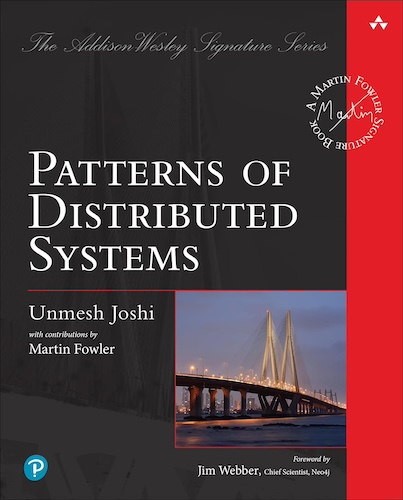Catalog of Patterns of Distributed Systems
Distributed systems provide a particular challenge to program. They often require us to have multiple copies of data, which need to keep synchronized. Yet we cannot rely on processing nodes working reliably, and network delays can easily lead to inconsistencies. Despite this, many organizations rely on a range of core distributed software handling data storage, messaging, system management, and compute capability. These systems face common problems which they solve with similar solutions.
In 2020 I began collecting these solutions as patterns, publishing them
on this site as I developed them. In 2023 these were published in the book
Patterns of Distributed
Systems. On this site I now have short summaries of each pattern, with
deep links to the relevant chapters for the online eBook publication on
oreilly.com (marked on this page with ).
Clock-Bound Wait 
Wait to cover the uncertainty in time across cluster nodes before reading and writing values so that values can be correctly ordered across cluster nodes.
Consistent Core 
Maintain a smaller cluster providing stronger consistency to allow the large data cluster to coordinate server activities without implementing quorum-based algorithms.
Emergent Leader 
Order cluster nodes based on their age within the cluster to allow nodes to select a leader without running an explicit election.
Fixed Partitions 
Keep the number of partitions fixed to keep the mapping of data to partition unchanged when the size of a cluster changes.
Follower Reads 
Serve read requests from followers to achieve better throughput and lower latency
Generation Clock 
A monotonically increasing number indicating the generation of the server.
Gossip Dissemination 
Use a random selection of nodes to pass on information to ensure it reaches all the nodes in the cluster without flooding the network
HeartBeat 
Show a server is available by periodically sending a message to all the other servers.
High-Water Mark 
An index in the write-ahead log showing the last successful replication.
Hybrid Clock 
Use a combination of system timestamp and logical timestamp to have versions as date and time, which can be ordered
Idempotent Receiver 
Identify requests from clients uniquely so you can ignore duplicate requests when client retries
Key-Range Partitions 
Partition data in sorted key ranges to efficiently handle range queries.
Lamport Clock 
Use logical timestamps as a version for a value to allow ordering of values across servers
Leader and Followers 
Have a single server to coordinate replication across a set of servers.
Lease 
Use time-bound leases for cluster nodes to coordinate their activities.
Low-Water Mark 
An index in the write-ahead log showing which portion of the log can be discarded.
Majority Quorum 
Avoid two groups of servers making independent decisions by requiring majority for taking every decision.
Paxos 
Use two consensus building phases to reach safe consensus even when nodes disconnect
Replicated Log 
Keep the state of multiple nodes synchronized by using a write-ahead log that is replicated to all the cluster nodes.
Request Batch 
Combine multiple requests to optimally utilise the network
Request Pipeline 
Improve latency by sending multiple requests on the connection without waiting for the response of the previous requests.
Request Waiting List 
Track client requests which require responses after the criteria to respond is met based on responses from other cluster nodes.
Segmented Log 
Split log into multiple smaller files instead of a single large file for easier operations.
Single-Socket Channel 
Maintain the order of the requests sent to a server by using a single TCP connection
Singular Update Queue 
Use a single thread to process requests asynchronously to maintain order without blocking the caller.
State Watch 
Notify clients when specific values change on the server
Two-Phase Commit 
Update resources on multiple nodes in one atomic operation
Version Vector 
Maintain a list of counters, one per cluster node, to detect concurrent updates
Versioned Value 
Store every update to a value with a new version, to allow reading historical values.
Write-Ahead Log 
Provide durability guarantee without the storage data structures to be flushed to disk, by persisting every state change as a command to the append only log.


